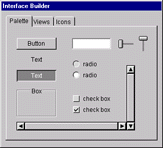|
||||||
Visit Pierre Arnaud's official home page.
|
||||||||
| Last updated 26 Octobert 1998. | Visit Pierre Arnaud's official home page. |
|||||||
News... |
. |
OPaC undergoing heavy changes. |
 |
The latest available version of the OPaC class library is OPaC 1.0.3. It is quite old now and does not include Linux/X11 support, since important low level modifications have been undertaken. The sources are available for download. OPaC is undergoing heavy changes. The next public version will most probably be available by the end of the year.
The most important changes since the first release are the support for alpha transparency and translucency, the use of the FreeType library for font rendering and a smart revisionless serialisation algorithm.
| OPaC support for transparency and 8-bit alpha translucency is 100% system independent. It is based on a set of custom 32-bit graphic routines used internally to draw into pixmaps. These pixmaps are then displayed on the host's display. [enlarged view of window]. |
Details about the new features (only up to 1.0.1) can be found here.
|
|
|||||||||||||||||||||||||||||||
|
|
|||||||||||||||||||||
 |
Please visit the OPaC tutorial. You will learn a lot about OPaC in a few minutes... It explains how to dynamically build a user interface for a simple demonstration program, which multiplies two real numbers and graphically displays the result. | |